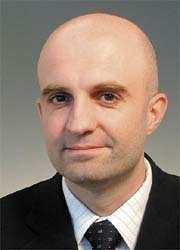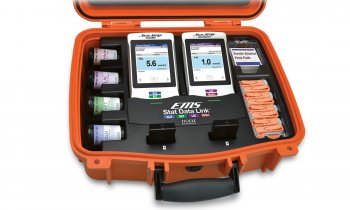Internationalising IT systems
Agfa climbs over language and healthcare practice barriers
In recent years, Agfa HealthCare has dramatically expanded its IT portfolio in line with its strategy to be an international leader in healthcare IT. At the recent ITeG exhibition in Frankfurt, the company's ambitions were clearly visible: Agfa very much focused on ORBIS, its leading Hospital Information System.
Daniela Zimmermann interviewed Eric Maurincomme, Vice President Business Development, Healthcare Business Group, Agfa, about the firm's continuing strategy

EM: ‘Strategically, Agfa decided to play a leading role in the convergence of IT solutions for healthcare providers. That meant expanding our core strengths in analogue and digital solutions for radiologists (from film to PACS), to other departments, such as cardiology, orthopaedics, women’s care, but also at the level of the enterprise. Keeping this in mind, we acquired in the past two years companies like GWI in Germany, Heartlab in the USA, Symphonie on Line in France, and Med2Rad in Italy. All these companies had very strong solutions for their market and the knowledge of how to deploy it effectively. The integration process has essentially 2 goals. The first one is to leverage beyond Radiology our global presence and leadership in Radiology Information Systems (RIS) and PACS. The second goal is to expand the acquired knowledge beyond its current geographical borders, i.e. we have ambitions beyond the German speaking market for our HIS/CIS business, and beyond the USA for our CardioVascular Information Systems.
During integration, we are bringing complementary skills of global deployment and core IT knowledge together, while for HIS and CIS, keeping a dedicated focus to the German speaking market, where we have established a name, brand and product line over the past decade. Likewise, in the USA, in cardiology, where we have a leading position.
How do you implement this approach in practice?
ORBIS is at the centre of our international expansion. We are doing two things in parallel. First, we need to set up the basic ‘platformisation’ for internationalisation, in order to enter different markets simultaneously. Not only the language, but also some basic processes are very different from country to country; for example, the pharmacy information system, i.e. the way medication is delivered and managed, requires different workflow in Germany and France. Recognising these different requirements led us to the second point.
Second, we are setting local R&D centres that can develop and integrate local requirements in the ORBIS platform. Taking the previous example, we already had an ORBIS pharmacy for Germany, and over the past 12 months, we have been developing and implementing the very different French ORBIS pharmacy modules. These developments took place in Bordeaux, which is our main ORBIS France development centre.
In the HCIT industry, you cannot rush the integration of the R&D roadmaps. Every customer has unique needs, every segment of the market is different, and every country has its own specificities. This is the reason why we have expanded ORBIS R&D centres outside Germany and Austria, in Belgium, France, and Italy.
Where are you today in your deployment efforts?
Since its introduction in France at the end of 2005, nearly 15 French university and community hospitals of various sizes, both public and private, have ordered ORBIS. The most recent is the Centre Hospitalier Universitaire of Toulouse, counting some 10,000 users. The first implementation in a French hospital is scheduled to go live this summer. In Luxemburg, the first hospital went live in June. At the same time, we are beginning the implementation of ORBIS in pilot sites in Belgium.
If you look at the ‘origin’ of the ORBIS platform in these hospitals, most of the developments come from Germany and Austria, but some of the key modules come from Gent and Bordeaux. It truly is a blend of all competences.
We will keep expanding beyond these initial European countries with our ORBIS platform. Again, we are present in over 40 countries with our Radiology IT offerings. And we spend the necessary time in analysing each market, systematically, before deciding how we should enter with our EPR platform
How does ORBIS relate to the electronic patient record (EPR) and the electronic health record (EHR)?
I would like to make a clear distinction between EPR and EHR. The EPR is generally linked to a hospital visit, and the EPR stores all the history and data that occurred between the admission and discharge of a patient. ORBIS is the foundation for an Electronic Patient Record (EPR). It consolidates the data related to every stage of treatment in hospital. Today, if a patient leaves an ORBIS hospital and returns six months later, the whole EPR is there, and the right information is available for the right user.’
On the other hand, you have the EHR, where you only want to store selected samples of the EPR. Why? Well, the EHR accompanies every citizen, and storing all information of every health episode in your life is just impossible. For example, after a heart attack, where all cardiology images are available within the hospital EPR, you only want to store the pre and post intervention images and related data in the EHR, so that you can appropriately monitor the patient. Usually, it is up to the local and regional authorities to establish the framework and policies related to the EHR.
Furthermore, there are geographical differences in the EHR deployment. One is the e-health smart card, which holds key medical information; the other is networked information databases, to which you gain access through the use of an electronic key, a e-health card being one example, but also potentially an electronic passport, or a fingerprint. The future might be a combination of these two trends: one to provide quick and vital information wherever the patient is, the other to allow extremely efficient management of the patient. The advantages to patients and to the quality of care are considerable and all efforts to achieve this as soon as possible are well spent.
Agfa HealthCare provides the technology that enables this patient-centric healthcare management, in a safe and secure manner. Again, the concept of ‘right information to the right person at the right time’ is of prime importance for healthcare providers, because they can’t afford to drown under irrelevant information. Information management, its distribution and availability, is what will allow clinicians, nurses, and any caregiver to improve efficiency and quality of care, while reducing medical errors.
01.07.2006











